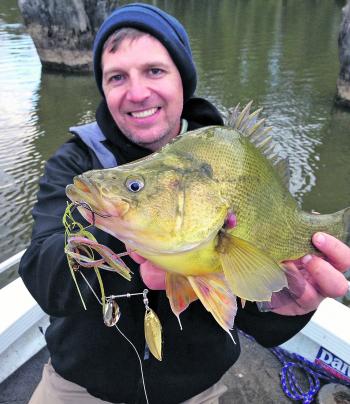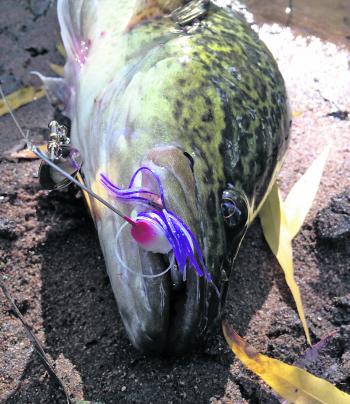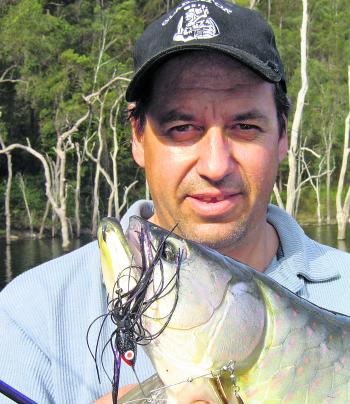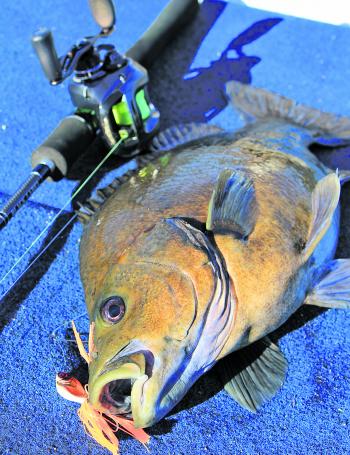Around fifteen years ago, spinnerbaits weren’t very popular at all. Of course, there were a few clued-up anglers throwing lures that looked like mini-coat hangers around – and catching great fish on them – but it wasn’t until the inception of the cast-and-retrieve bass fishing tournaments that spinnerbait use became more mainstream.
And although Australian bass were the focus of these initial journeys into spinnerbait-land, it so happens that most Australian native species – from sooty grunter and saratoga in the north through to Murray cod and yellowbelly in the south – love a spinnerbait.
In the subsequent 15 years, spinnerbaits have become commonplace on the walls of tackle stores and a burgeoning cottage industry has developed to supply this local market.
But if you’re not into the spinnerbait thing, what are they and what are you missing out on?
You can see on the enormous spinnerbait anatomy pic here that there’s a few parts to a spinnerbait, but the end result is a lure that creates a lot of flash and vibration, rides hook-up, is easy to cast and catches fish on a straight retrieve. You don’t need to add any extra action for these lures for them to be effective and you can fish them on wither braided or monofilament line.
Frequent spinnerbait users will most likely tell you that braided line will give you more feel. You can usually feel the blades of a spinnerbait vibrating through braided line and a mono leader and if it gets fouled with weed, you know to rip the bait to get the lure free of the gunk and spinning freely again.
Wind a spinnerbait fast as soon as it lands and it’ll work right under the surface. “Buzzing” a spinnerbait like this lets you cover water fast when the fish are up and feeding. Alternatively, let the spinnerbait to the bottom and wind it ‘low and slow’ to tempt fish that are near the bottom.
All in all, the spinnerbait is a great all round bait that have now caught countless people bass, yellowbelly, cod, saratoga and sooties.
Although there can be some wild and wacky variations on the theme, the spinnerbait consists of a basic collection of parts, and the parts control its action, appearance, running depth and overall fishability. Let’s look at them one by one.
Wire
The wire is the backbone of the bait, but it controls a lot about how the spinnerbait swims. Fine wired spinnerbaits have less resistance in the water and tend to swim deeper.
This can be an advantage when fish are holding deep on a lake but you want to run a spinnerbait past them in 20 feet. Fine wired spinnerbaits with a heavy head an low resistence blades are good for this.
Head
The spinnerbait head holds most of the weight of the spinnerbait. It’s usually molded from lead and painted with a set of eyes. It holds the hook securely to the wire and also provides a place for the skirt to mount.
Nearly all spinnerbaits have a head that allows them to brush across snags and obstacles without hanging up.
Obviously, heavier heads run deeper and cast further and lighter heads will run shallower.
Spinnerbait hooks are usually rounded and wide gaped. Since they are supplied with only one, it needs to be a gauge strong enough to handle the fish you’re likely to encounter.
On the other side of the equation, though, there’s not much leverage a fish can gain against one hook, so it’s rare for a well hooked fish to fall off mid-fight.
Some anglers counter short-striking fish by adding a ‘trailer’ or ‘stinger’ hook ganged to the main hook. There are special, wide-eyed hooks available for this and they can be kept in place by a lumo bead or something as simple as a tab of milk-bottle plastic threaded onto the main hook after the stinger has been added.
This is one of the two areas where spinnerbaits can differ a lot. Traditionally, spinnerbait skirts are made from a bunch of silicon strands, and the number of strands included can increase or reduce the bait profile in the water.
Personally, I think that a sparse skirt looks more realistic, but there are situations in dirtier water where the bulk can be advantageous.
In lieu of a skirt, you can mount a paddle tailed soft plastic or even tie some bucktail on the head to create the baitfish profile. The world is your oyster in this regard.
Trailer
If you hear people talking about a ‘trailer’ for the spinnerbait, it’s when they add a soft plastic in addition to the skirt. This creates a bigger target for the fish and also makes the spinnerbait run a little shallower, due to the greater resistence.
Single tailed-, paddle tailed- and shad-style plastics are all popular to use as trailers and yellowbelly and cod anglers are more prone to using them.
Blades really define the action of the spinnerbait and the number and type of blades give the bait its own, unique action.
There are two, basic types of blades, a rounded “Colorado” blade and an elongated “willow” blade. And the most popular spinnerbait configuration is a “Tandem”, which consists of a small Colorado blade up front and a bigger willow blade at the end of the wire.
Colorado blades offer more vibration and more resistance while the longer willow blades feature less frsistence and more flash.
With this in mind, you can then construct (or choose) a spinnerbait configuratiuon that suits your style of fishing.
If you’re fishing a shallow, snaggy, dirty river for Murray cod, you may choose a ‘double Colorado’ configuration spinnerbait with a bulky skirt and a fat trailer plastic.
Likewise, if you’re trying to fish a spinnerbait down deep for an impoundment bass on light line, you might opt for a heavy head, sparse skirt and a single willow blade.
Making your own spinnerbaits is quite a popular pastime for anglers who like catching fish on lures they’ve made themselves. It’s not as hard as you’d think – although it is more complicated than molding your own soft plastic lure.
Kits and molds are available in Australia and the process involves casting the head around the hook and wire, painting the head, adding the skirt and finally adding the right combination of blades.
So if you’ve never tried them, you should add some spinnerbaits to your freshwater kit. When that first, crunching strike comes, you’ll be glad you did!
Reads: 3760
Yellowbelly love a spinnerbait slow-rolled past their nose.

The ability to fish your spinnerbait through the nastiest of structures makes makes them a primary tool for many cod anglers.

Surprisingly, saratoga are suckers for spinnerbaits fished around the wooded margins of toga waters.

Aussie bass were the catalyst for early spinnerbait uptake in Australia.

Sooty grunter are famous for being not fussy when it comes to lures that grab their attention. I once said they’d eat a shoe if you threw it in the water. Spinnerbaits are a great substitute for shoes if you need them to walk out of your sooty local.








